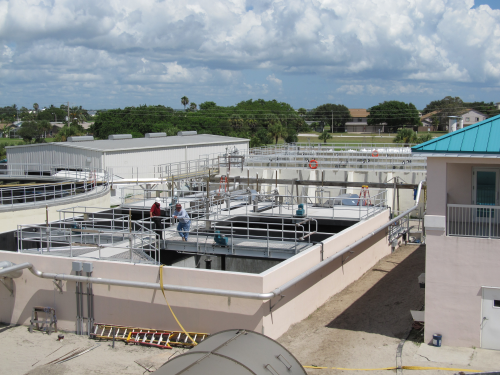
The City of Cocoa Beach faced some challenges. USEPA had established Total Maximum Daily Loads (TMDLs) for nutrients and dissolved oxygen (DO) in the Indian River and Banana River Lagoons in East Central Florida. The city’s 6.0 MGD water reclamation plant would therefore need to significantly reduce nutrients in its effluent. Due to its location, any modifications would need to be within the existing plant boundaries. Construction would need to take place while the plant remained online. And the city would need to continue to serve its reclaimed water system that beneficially reclaimed over 90% of the effluent.
To these challenges, the city added some additional goals. At the same time the city wanted to identify the lowest cost solution to meet the effluent limits, the city wished to reduce energy consumption and maintain the existing operations and staffing requirements.
Achieving optimum rates
Given the need to create pre-anoxic and post-anoxic treatment zones with minimal space, and factoring in cost, the City of Cocoa Beach selected the AnoxKaldnes Hybrid Biofilm Activated Sludge (Hybas) IFAS technology. An aerobic SRT of 2.25 days was needed for optimal growth of Phosphorous Accumulating Organisms (PAOs). To achieve optimum rates of nitrification and meet the effluent TN limit of 3 mg/L, two aerobic reactors in series were designed. The first was an IFAS reactor with media and the second was an activated sludge reactor without media.
The final design retrofitted six existing A/O basins into six parallel IFAS process trains. Each process train consisted of one preanoxic basin, one aerobic IFAS basin, and one aerobic activated sludge basin without media. In order to achieve an effluent TN of less than 3 mg/L, two post-anoxic process trains, each with two post-anoxic basins in series, were constructed. The total SRT in the new constructed post-anoxic basin was 0.5 days, and the total SRT in the entire system was around four days. The total aerobic fraction is about 55% of the total volume.
Process description
The project goals included sustainability and efficiency. The biological process and the equipment selected achieved both. Benchmarks often used to measure sustainability and efficiency are nutrient reduction, residuals production and energy consumption. Upon project completion, the plant saw a decrease in nutrient mass, sludge residuals and unit energy consumption. The data collected proves the reduction for all three parameters.
The Hybas process effectively reduced effluent nitrogen from an average of 8.64 mg/L in 2011 to 1.62 mg/L in 2013. This represented an 81% reduction in effluent TN values. The pre-IFAS baseline value for effluent total phosphorous (TP) was approximately 1.6 mg/L. After project completion and prior to commencing alum feed, the effluent values for TP were 0.46, 0.36 and 0.40 mg/L. This represented a 32% reduction in TP and exceeded the design limit of 1.0 mg/L.
Results
The combination of process design and equipment selection resulted in a completed treatment facility with equal hydraulic treatment capacity, advanced nutrient removal capability, and decreased power requirements. The reduction in energy usage is evidenced by a decrease in connected horsepower and a significantly lower unit power consumption. In terms of connected horsepower, the total load assigned to blowers, mixers and pumps was reduced by 220 HP. Prior to construction, the total rated horsepower for all blowers, mixers and pumps was approximately 1,200 HP.
In the post-construction condition, the total connected load was reduced to 980 HP. This represented a reduction of approximately 18% in terms of connected load. With the AnoxKaldnes Hybas IFAS system, the City of Cocoa Beach met the challenges of tighter nutrient regulations, site constraints, and operating conditions. And the project met the city’s goals to meet these challenges with a simultaneous decrease in energy use. On top of that, the city did not need to increase operations time or staffing to meet these goals. With the AnoxKaldnes Hybas IFAS system, the city is now meeting stricter nutrient regulations – and doing it sustainably.




